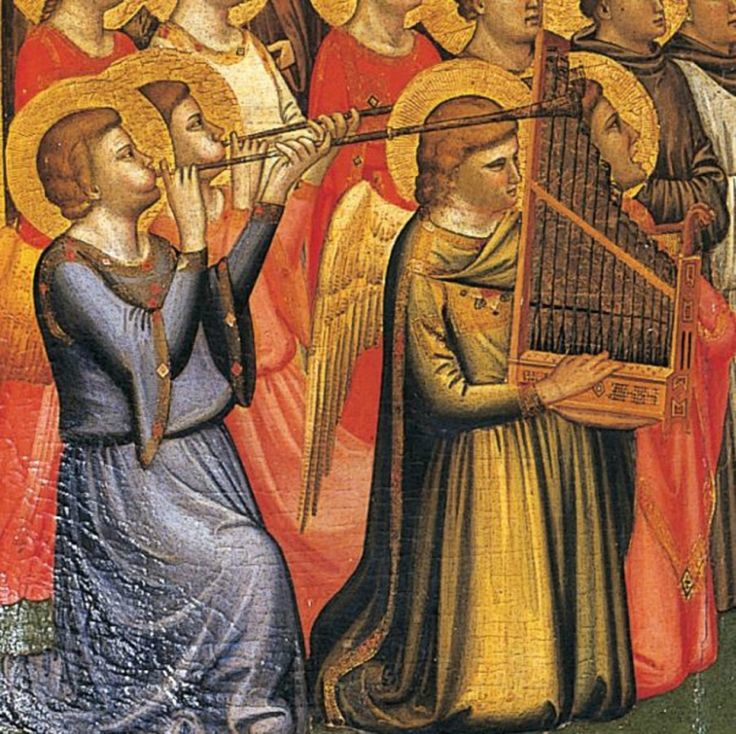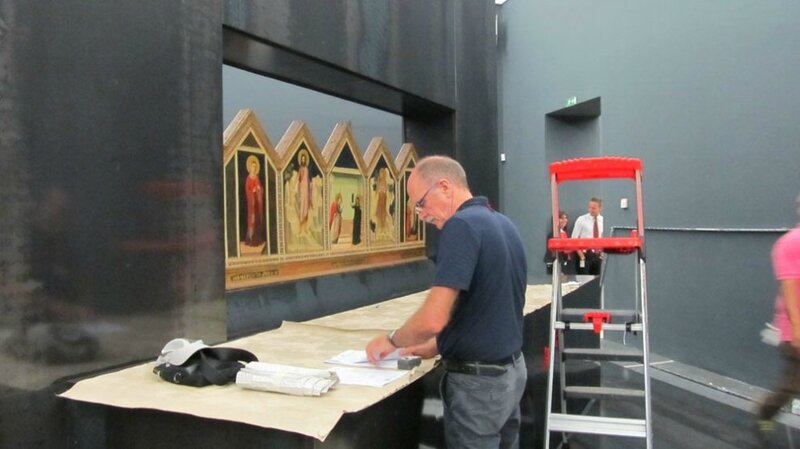Giotto, l’Italia: Major exhibition of works by Giotto opens at Palazzo Reale in Milan
MILAN.- Giotto, l’Italia, is the major exhibition that will conclude the semester of Expo 2015 at the Palazzo Reale in Milan. The exhibition, sponsored by the Ministry of the Heritage, Cultural Activities and Tourism and the City of Milan–Culture, and devised by Éupolis Lombardia to a scholarly project by Pietro Petraroia and Serena Romano, who are also the curators, it is produced and organized by Palazzo Reale and the publishing house Electa. The exhibition is an outstanding chapter in Expoincittà, the calendar of events that will be part of the city’s cultural life during the Expo semester, and is included in the “Agenda Italia per Expo 2015.” Giotto, Italia will remain open to the public from September 2, 2015, until January 10, 2016. The exhibit design by Mario Bellini will be installed in the galleries of Palazzo Reale where Giotto, in the Visconti period, painted his latest work, unfortunately lost: the frescoes in the palace of Azzone Visconti.
Giotto, Head shepherd (the Badia Fiorentina) - The decade of the fourteenth century fresco fragment of Florence, Accademia Gallery Superintendence for the historical, artistic and ethno-anthropological and the museum center of the city of Florence.
The exhibition is guided by a prestigious Scholarly Committee comprising the directors of Italian institutions that over the years not only have contributed to the preservation and protection of Giotto’s works, but have also to a very remarkable degree enlarged our knowledge and scholarly and technical understanding of the master’s painting, with internationally significant and advanced studies and contributions. The Committee consists of the president Antonio Paolucci and Cristina Acidini, Davide Banzato, Giorgio Bonsanti, Caterina Bon Valsassina, Gisella Capponi, Marco Ciatti, Luigi Ficacci, Cecilia Frosinini, Marica Mercalli and Angel Tartuferi.
Giotto, God the Father enthroned, detail, ca 1303-1305. Tempera on wood. Padua, Civic Museums of Padua. Courtesy of the City of Padua Department of Culture Tourism and Innovation.
The project team includes the Directorates for the Heritage, the museums and religious institutions that preserve works by Giotto: the Vatican Museums; the Gallerie dell’Accademia and the Gallerie degli Uffizi in Florence; la Directorates of Fine Arts and Landscape for the provinces of Florence, Pistoia and Prato; the Pinacoteca Nazionale of Bologna and the Polo Museale of Bologna and the Polo Museale of Emilia Romagna; the San Diego Museum of Art – California; the Fund for Places of Worship of the Interior Ministry; the Musei Civici agli Eremitani in Padua, the Directorates of Fine Arts and Landscape for the provinces of Venice, Belluno, Padua and Treviso; the parish church of San Lorenzo, Borgo San Lorenzo (Florence);; the Museo Diocesano of Santo Stefano al Ponte, Florence; the Opera di Santa Maria del Fiore and the Opera di Santa Croce in Florence, and the Florence Archdiocese.
Giotto, Polyptych Baroncelli, detail, central compartment: Coronation of the Virgin elements side, Saints and Angels musicians, ca. 1330, tempera and gold on wood, from the Basilica of Santa Croce, Cappella Baroncelli (Florence). By permission of the Basilica of Santa Croce, Florence / Fund places of worship of the Ministry of the Interior.
In the extensive enhancement project involving the places in Italy where Giotto worked, the exhibition offers the cosmopolitan public of visitors to Expo the opportunity to view the great masterpieces of the founder of Italian figurative culture, Dante Alighieri’s alter ego in the field of painting.
The title Giotto, Italia, is intended to stress the revolutionary role of the Florentine painter who was summoned by Cardinals, religious orders, bankers, and even the king of Naples to work in many places and cities in Italy. Wherever Giotto worked he exerted a great power of attraction over the local schools and artists by his innovatory style, permanently changing the bearings of Italian figurative art.
Giotto, Polyptych Baroncelli, ca. 1330, tempera and gold on wood, from the Basilica of Santa Croce, Cappella Baroncelli (Florence). By permission of the Basilica of Santa Croce, Florence / Fund places of worship of the Ministry of the Interior.
The exhibition at the Palazzo Reale brings together 13 works, mostly on panel, none of which have ever been exhibited in Milan before and forming a sequence of masterpieces never presented in a single exhibition. The provenance of each is established so that together they document Giotto’s travels through the Italy of his time during some forty years of outstanding achievement.
The exhibition firstly presents the galleries displaying his youthful works. The fragment of the Maestà of the Virgin from Borgo San Lorenzo and the Madonna from San Giorgio alla Costa document the period when the young Giotto was active in Florence and Assisi. Then comes the core of works from the Badia Fiorentina, with the polyptych of the high altar, around which will be reassembled the fragments of fresco decoration that surrounded the altar. The panel with God the Father enthroned comes from the Scrovegni Chapel and documents his Paduan phase. There follows the extraordinary group that starts with the double-sided polyptych for the Florentine cathedral of Santa Reparata, with its point of arrival in the Stefaneschi polyptych, the masterpiece painted for the high altar of Saint Peter’s in Rome.
Giotto, Polyptich Bologna, about 1333, tempera and gold on wood from the Church of Santa Maria degli Angeli (Bologna), Bologna, National Picture Gallery. Courtesy of the Ministry of Heritage and Culture and Tourism - Pinacoteca Nazionale, Bologna.
The exhibition layout is brought to an end with the paintings from the phase of the master’s career: the Bologna altarpiece, which Giotto painted in the context of the planned return to Italy, in Bologna, of the papal court then in Avignon; and the Baroncelli altarpiece in the chapel of the same name in the church of Santa Croce in Florence, which will be reunited in the exhibition with its cusp, depicting the Eternal Father, now in the Museum of San Diego in California.
Such outstanding loans are the fruit of far-sighted cooperation between institutions and owners and the scholarly and technical support provided by many offices of the Ministry of Cultural Assets and Activities and Tourism.
Giotto, Stefaneschi Triptych, verso, the second decade of the fourteenth century, tempera and gold on wood, from the Basilica of St. Peter's (Rome), Vatican City, Vatican Museums Service. Photo Courtesy of the Vatican Museums, © Governor of Vatican City.
Thanks to the use of appropriate technologies and the skill of experts, the exhibition will be completed by the enthralling experience of a close viewing of the frescoes Giotto painted on the walls of the Peruzzi Chapel in the church of Santa Croce in Florence. The cycle, which was badly damaged by repainting and poor restoration, has recently been subjected to a project directed by the Opificio delle Pietre Dure in Florence and supported by Villa I Tatti The Harvard University Center for Italian Renaissance Studies.
Giotto, Stefaneschi Triptych, recto, the second decade of the fourteenth century, tempera and gold on wood, from the Basilica of St. Peter's (Rome), Vatican City, Vatican Museums Service. Photo Courtesy of the Vatican Museums, © Governor of Vatican City.
The work involved subjecting the frescoes to innovative investigation, in particular by using ultraviolet photography, which is unusual for paintings of this kind. It reveals a Giotto who could never be seen by the naked eye, of a quality otherwise unimaginable. To date only a privileged few have been permitted to climb the scaffolding installed in the chapel to enjoy this remarkable experience. Offering it now to the broader public of the exhibition and Expo Milano 2015 also means paying tribute to the tradition of scientific excellence that Italy has constructed, over many decades, in the restoration, conservation and understanding of its historical artistic heritage.
Giotto, Stefaneschi Triptych, detail, the second decade of the fourteenth century, tempera and gold on wood, from the Basilica of St. Peter's (Rome), Vatican City, Vatican Museums Service. Photo Courtesy of the Vatican Museums, © Governor of Vatican City.
Paolo Uccello, detail of Five Masters of the Florentine Renaissance (or Fathers of Perspective), a portrait of Giotto), c. 1450, Tempera on wood, 43 x 210 cm, Musée du Louvre, Paris. Creative Commons Attribution-Share Alike 3.0 Unported license.
The great masterpieces by Giotto in Milan, the backstage of the show
The great masterpieces by Giotto on show in Milan at the end of the first half of the Expo. Fourteen key works in the production of the Master, including the Altarpiece Stefaneschi made for the high altar of St. Peter's coming out for the first time in 700 years since Vatican. 'Giotto, Italy' is the title of the exhibition (curated by Serena Romano and Peter Petraroia, staging by Mario Bellini, produced by the Royal Palace and the publishing house Electa), which opens on September 2 at the Palazzo Reale in Milan and that these days is under construction. Here's a preview of some photos taken during the work unpacking, inspection and assembly of works by Rosa Fasan and Manuela Piedmont. (source: http://milano.repubblica.it/)

/https%3A%2F%2Fprofilepics.canalblog.com%2Fprofilepics%2F1%2F0%2F100183.jpg)
/https%3A%2F%2Fstorage.canalblog.com%2F03%2F02%2F119589%2F96711876_o.jpg)
/https%3A%2F%2Fstorage.canalblog.com%2F11%2F31%2F119589%2F94773502_o.jpg)
/https%3A%2F%2Fstorage.canalblog.com%2F20%2F83%2F119589%2F94772815_o.jpg)
/https%3A%2F%2Fstorage.canalblog.com%2F26%2F72%2F119589%2F75604929_o.jpg)
/https%3A%2F%2Fstorage.canalblog.com%2F59%2F60%2F119589%2F26458628_o.jpg)





























/image%2F1371349%2F20240418%2Fob_ac5c4c_telechargement.jpg)
/image%2F1371349%2F20240418%2Fob_709b64_304-1.jpg)
/image%2F1371349%2F20240418%2Fob_22f67e_303-1.jpg)
/image%2F1371349%2F20240417%2Fob_9708e8_telechargement.jpg)